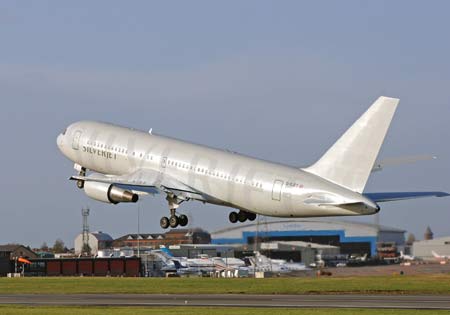
Lawrence Hunt is the third chief executive to launch an all-premium carrier in the London-New York market but he is not worried about the intense competition.
UK-based Silverjet began operating in late January a Boeing 767 configured with 100 angled lie-flat business-class seats. It joins Eos and Maxjet, both of which launched all-premium services in late 2006, competing against American Airlines, British Airways, Continental Airlines, Delta Air Lines and Virgin Atlantic in the crowded London-New York market. But Hunt is quick to point out Silverjet’s single frequency between Luton and Newark airports is just a drop in the bucket when taking into account the 4.2 million passengers that now fly annually between London and New York, 1.2 million of which sit in premium sections of the cabin.
“Between Maxjet, Eos and us we’ve added 250 premium seats per day in the last 18 months in a 7,000-seats-a-day market,” says Hunt.
He claims premium cabins on London-New York flights are now averaging a load factor exceeding 90%. With the UK-US bilateral restricting new carriers from entering the market, Hunt does not see these load factors decreasing, especially if the US and UK economies continue to stay hot. He claims when Silverjet adds a second daily Luton-Newark flight at the beginning of July and a third flight at the end of the year, his seats will fill fast and legacy carriers will continue to keep their business class fares at about £3,000 ($5,900) return.
Like Maxjet, Silverjet is targeting passengers that now fly economy or premium economy rather than business class. Its roundtrip fares, which start at £800 return, are priced below the typical premium economy fare offered by BA and Virgin. The London-New York premium market now accounts for about 460,000 passengers per year.
“We will grow the overall size of the business class market by taking on economy and premium economy passengers,” Hunt says. “A lot of our customers are switching from major carriers but have traditionally flown economy or premium economy.”
The seat
Silverjet’s seat has a 4% incline, while the business class seat offered by BA, Eos and Virgin are horizontal lie flat. But Hunt claims the Silverjet seat is almost as good and is a much better deal. Eos, which operates 757s with only 48 seats, is targeting business-class passengers seeking a first-class experience at a business-class fare.
“The aircraft flies at a nose-up angle so you hardly notice it,” Hunt says of the 4% angle. “Business travellers complain about a lack of sleep. Being able to sleep four to five hours from New York really helps.”
To facilitate sleep on the overnight flight from New York to Luton, Silverjet crews turn off the lights right after takeoff, refrain from making any announcements except for those pertaining to safety and offer an express breakfast in a box that passengers can carry as they get off the aircraft. For passengers with more time, a buffet breakfast is also served at Silverjet’s private terminal at Luton. The facility, which used to be part of Luton’s old passenger terminal, has a dedicated immigration and customs facility that can process 100 passengers in only 30 minutes. Complimentary taxis are available to whisk passengers to the terminal from Luton’s train station.
“We’ve created a private business jet experience,” Hunt says.
Silverjet is now working to duplicate the Luton experience at Newark, where it operates from Terminal B. “We expect within 18 months we’ll have a new facility creating a similar experience,” Hunt says. “We’re having various discussions with Newark.”
Silverjet is now operating only one 767 it inherited from its acquisition late last year of small international passenger carrier Flyjet, which gave Silverjet an instantaneous air-operators certificate. It has already committed to taking a second 767 in March, which is being acquired from Thomsonfly and will be sold and leased back from Novus Aviation. It will be placed into service after it is retrofitted with new business-class seats, a process that will take eight to 12 weeks. A third 767, also being acquired from Thomsonfly with financing from Novus, will be delivered in October and ready for service by year-end.
Hunt is confident the first three aircraft can be filled up exclusively with London-New York flights. “Looking at sales figures on my laptop we’re well above projections,” he says.

Hunt has stayed away from smaller markets initially to avoid stiff competition from legacy carriers. He points out Maxjet only lasted a few months on its second route, London Stansted to Washington Dulles, because the London-Washington market is only 800,000 passengers per year and legacy carriers were more willing to reduce their business-class fares. On the London-New York market, he claims legacy carriers will not reduce their typical £3,000 business-class fare because it will have too much of an impact given the high number of frequencies they operate.
“Start-up airlines need to focus on big lumpy high yield routes,” Hunt says.
Silverjet is considering nine other transatlantic routes but it is also looking at more than 20 destinations in Africa, Asia and the Middle East. He says when Silverjet adds new destinations in 2008, when it will likely take two more ex-Thomsonfly 767s, they will not all be to North America because Silverjet wants to avoid competing against the same set of carriers and being exposed to a regional downturn.
“Our major concern is we don’t want too much exposure in the North Atlantic. We want to balance our risks,” he says.
Silverjet’s lightly loaded 767s can operate up to 14 hours from Luton, which make destinations as far as Johannesburg in South Africa feasible. Overall Hunt claims there is sufficient demand for at least 30 all-premium routes from Luton.
“It’s based on existing data,” he says. “We could do all of them, although some may take three to four years of negotiations” to get the required government clearances.
To facilitate route launches in countries that do not have room for new-entrants in their existing bilaterals, Hunt is considering forging partnerships with foreign carriers. These could take the form of joint ventures or outright acquisitions.
“We have lots of discussions going on about partnership opportunities in the Caribbean, India, China and Southeast Asia,” he says.
Hunt acknowledges legacy carriers will likely react more viciously if Silverjet launches into smaller markets. But he claims by the time it adds new routes in 2008 Silverjet will be able to compete head to head with legacy carriers because even if they match its fares, Silverjet’s costs will be lower.
“We run on low-cost principles so we’ll be able to reduce our fares,” he says, pointing out Silverjet will stick with one aircraft type and operate with a small accounting department.
To keep costs down, it also will not codeshare or interline with other carriers although joint marketing of flights is a possibility.

Pre-launch IPO
Silverjet has the funds to quickly expand, having raised £25 million last May in an initial public offering (IPO). Hunt claims interest in the shares, traded on the London Stock Exchange, exceeds demand and Silverjet can go back to the stock market for another offering if more capital is required.
“We looked at a number of funding options. Venture capitalists are loath to invest in start-ups and private equity isn’t a big investor in the airline sector unless you have a steady cash flow,” he says. “The [IPO] process went like a dream. We raised more than we thought and did it very quickly.”
Most of the stock is held by a group of 30 institutional investors who Hunt says are long-term minded and do not meddle in the everyday management of the airline. About 20% is held by small private investors.
Hunt is not an aviation industry veteran but is an expert when it comes to starting companies and securing initial financing. Before starting to look at the all-premium airline market in 2004, he successfully started three technology companies and three companies in the travel industry – one travel agency, one online agent and one tour operator.
“We got a hugely experienced team that has done 20 start-ups between them,” he says.
For airline industry knowledge, Hunt can call on chief financial officer John Bavister, customer service director Martyn Bridger and operations director Peter Evans. Bavister formerly held senior financial posts at MyTravel and Thomas Cook. Bridger was head of in-flight services at British Airways until 2000, when he became a consultant and worked for several carriers including Emirates, Etihad and Qatar Airways. Evans is a former head of operations at Virgin Atlantic, where he grew the fleet from two to 25 aircraft, and later turned around MyTravel.
“It’s my first airline venture. I love it. It’s a fascinating business and the numbers are great,” Hunt says, adding with an 80% load factor, Silverjet will turn a £5 million operating profit per aircraft on a £40 million asset.
Several companies tried starting up in the all-premium market before Eos and Maxjet but failed to launch. Hunt cannot figure out why all of a sudden there are four all-premium carriers in the transatlantic market (the fourth is France-based L’Avion, which launched in the Paris-Newark market in January) and says the market is big enough for several players.
“The market is ripe now for investors who have the appetite for it,” Hunt says. “I was just at the time of my life to start a new company and this idea fascinated me. If others want to join the party, great, it helps us create the market.”
Click here for more Airline Business interviews
Source: Airline Business
















